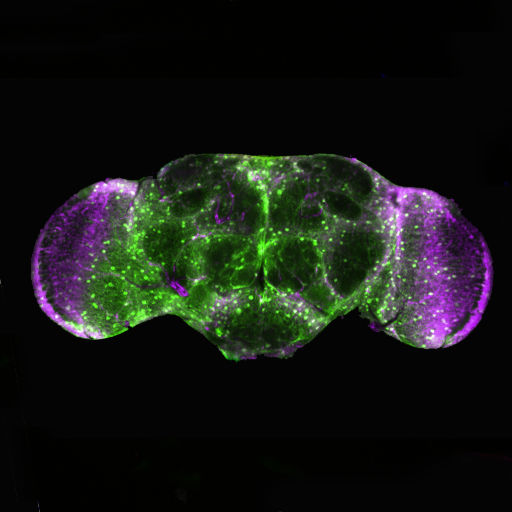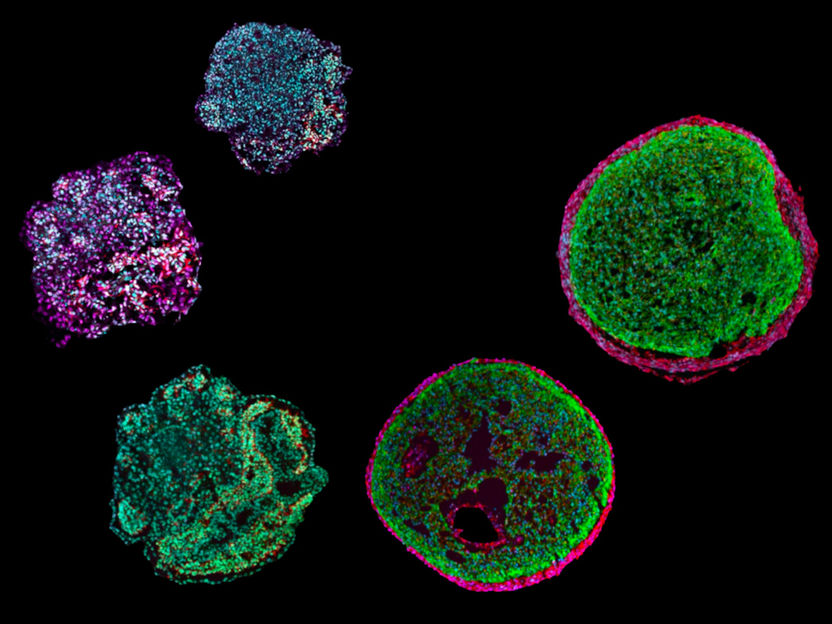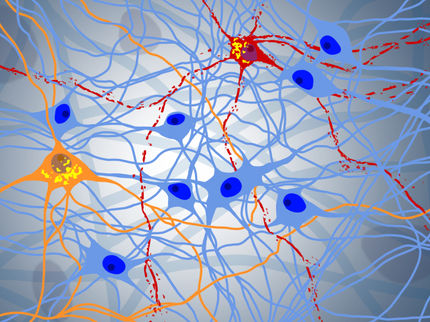Toxic proteins cause neurodegeneration in motor neuron disease and dementia
Recent findings in basic biomedical research might pave the way towards novel therapies: Scientists at the Max Planck Institute for Biology of Ageing in Cologne and University College London have now unearthed the way in which a specific genetic mutation leads to neuronal damage in two serious afflictions, that might even occur at once in a single person: Until now, it has been unknown what causes amyotrophic lateral sclerosis and frontotemporal dementia.

In the fruit fly Drosophila melanogaster, scientists can study very well how nerve cells are damaged. The picture shows the brain of an adult fly (glial cells are stained green, cell nuclei purple).
Dr. Teresa Niccoli, University College London, UK
Amyotrophic lateral sclerosis is a devastating type of motor neuron disease that causes rapid weakening of muscles and death. Frontotemporal dementia is the second most common cause of dementia in people under 65. It causes distressing symptoms, including changes in personality and behaviour and problems with language and thinking.
The DNA of affected patients contains a mutation: There are thousands of repeats of a specific short segment of genetic material, whereas in unaffected persons, there are only up to thirty copies of this segment. This specific genetic alteration is the cause of illness in around eight percent of patients with this type of motor neuron disease or dementia. Eight percent is a relatively high proportion. For instance, less than one percent of the causes in Alzheimer’s disease are genetic.
Researchers at the Max Planck Institute for Biology of Ageing, the Institute of Neurology and Institute for Healthy Ageing at University College London have now discovered that the repeats in the mutant gene cause neurodegeneration by making toxic proteins.
Fruitflies can undergo neurodegeneration in a similar way to humans
Previously it was thought that the problem could be a consequence of disruption of the gene by the inserted repeats. Another theory was that the repeats produce a different type of toxic RNA molecule. It now turns out that the repeats in the mutant gene can produce a variety of proteins and that two of these are extremely toxic to nerve cells. Both are highly enriched in arginine, an amino acid.
To pinpoint the role of the toxic proteins, the researchers produced artificial repeat segments that could produce potentially toxic RNA and protein or only toxic RNA or only protein. They then introduced them into the nerve cells of fruit flies, which can undergo neurodegeneration in a similar way to humans. Repeat segments that made both RNA and protein caused striking neurodegeneration and reduced the lifespan of the flies, showing that they are a good organism in which to study these diseases. Interestingly, the protein-only repeat segments caused just as bad a neurodegeneration. In contrast, the RNA-only segments were harmless, pinpointing the role of toxic proteins in these diseases. The proteins that contained arginine were the most toxic.
These findings have uncovered a new toxic role for arginine-containing proteins in motor neuron disease and dementia, which helps in the development of drugs to fight these serious afflictions.
Original publication
C9orf72 repeat expansions cause neurodegeneration in Drosophila through arginine-rich proteins. Sarah Mizielinska et al.; Science Express, August 7, 2014.
Most read news
Original publication
C9orf72 repeat expansions cause neurodegeneration in Drosophila through arginine-rich proteins. Sarah Mizielinska et al.; Science Express, August 7, 2014.
Topics
Organizations
Other news from the department science

Get the life science industry in your inbox
By submitting this form you agree that LUMITOS AG will send you the newsletter(s) selected above by email. Your data will not be passed on to third parties. Your data will be stored and processed in accordance with our data protection regulations. LUMITOS may contact you by email for the purpose of advertising or market and opinion surveys. You can revoke your consent at any time without giving reasons to LUMITOS AG, Ernst-Augustin-Str. 2, 12489 Berlin, Germany or by e-mail at revoke@lumitos.com with effect for the future. In addition, each email contains a link to unsubscribe from the corresponding newsletter.
More news from our other portals
Last viewed contents
Causus_rhombeatus
University of Florida and Cyntellect Collaborate to Unlock Mysteries of Cancer Stem Cells - In situ processing by LEAP system to enable novel experiments with

Intana Bioscience GmbH - Martinsried, Germany
How Drugs Can Minimize the Side Effects of Chemotherapy
Surface hygiene test wins the Chemical Industry Innovation Award






















































